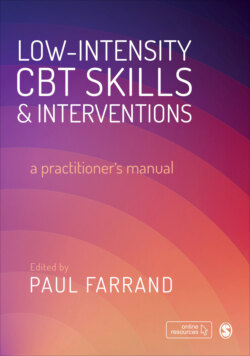Читать книгу Low-intensity CBT Skills and Interventions - Группа авторов - Страница 7
На сайте Литреса книга снята с продажи.
Foreword
ОглавлениеDavid M. Clark
Low-intensity CBT interventions have had a profound impact on the provision of psychological therapy for common mental health problems in the UK and in many other countries. It has long been recognised that cognitive-behaviour therapy is effective in the treatment of depression and anxiety related problems. However, public provision was held back by the high cost of traditional face-to-face CBT. Starting in 2004, the National Institute of Health and Social Care Excellence (NICE) issued a series of clinical guidelines that suggested a way forward. Emerging research suggested that many people with mild to moderate depression and/or anxiety might benefit from interventions that involved less therapist input (hence ‘low intensity') but still faithfully imparted the CBT skills that patients would find helpful for managing their emotional difficulties. This opened up the concept of a cost effective ‘stepped care’ system in which a substantial proportion of people would start treatment with a low-intensity intervention. Many should find that the low-intensity intervention alone met their needs. Some would find that, although helpful, low-intensity intervention alone was insufficient and subsequent ‘stepping up’ to a more traditionally delivered high-intensity CBT or other therapy would be required.
In 2006 the UK Department of Health funded two pilots to examine whether: low-intensity interventions could be offered at scale in routine services; could achieve the outcomes achieved in previously published randomised controlled trials; and could be incorporated within an integrated stepped care system. The pilots (which were in Doncaster and Newham) were a resounding success (Clark, Layard, Smithies, Richards, Suckling, and Wright, 2009). Overall outcomes were in line with what one might expect for CBT and large numbers of people were treated, with the provision of low-intensity interventions being critical to helping large numbers of people.
Building on the success of the Doncaster and Newham pilots, the UK government announced the creation of a national stepped care therapy programme called Improving Access to Psychological Therapy (IAPT). From small beginnings in 2008, IAPT has now grown to a point where it provides a course of treatment to around 605,000 people a year, with the government committed to expanding to almost 1 million people each year by 2024. A unique session by session outcome monitoring system tracks patients’ progress throughout low- and high-intensity therapy. Outcomes are in line with expectation. Approximately five in every ten treated patients recover and seven in every ten show substantial and worthwhile improvement. Low-intensity CBT continues to be at the heart of the programme and has shown its worth year in and year out.
Of course, low-intensity CBT can only achieve excellent clinical outcomes if its practitioners are well-trained, have acquired the necessary clinical skills, are well-supported by regular supervision, and work in services that pay attention to the well-being of their staff as well as that of their clients. This is where the excellent Low-intensity CBT Skills and Interventions: A Practitioner's Manual so wonderfully hits the spot. Paul Farrand, one of the leading originators of low-intensity work, has assembled an outstanding group of authors, all of whom are LICBT experts. Together they have produced a comprehensive series of chapters that take students, experienced practitioners and teachers through all aspects of the LICBT practitioner role. The key concepts underpinning low-intensity work and how it differs from more traditional delivery of CBT are clearly articulated. It is a different and important way of working and this is made very clear. The manual then provides invaluable guidance on how to conduct low-intensity assessments and to support patients through the full range of NICE recommended low-intensity therapies. The social context in which interventions are delivered is crucial and suitable adaptions for particular populations are clearly described. An invaluable practitioner manual.David M. ClarkNational Clinical and Informatics Advisor for IAPT; Professor of Experimental Psychology, University of Oxford.
David M. Clark
National Clinical and Informatics Advisor for IAPT; Professor of Experimental Psychology, University of Oxford
